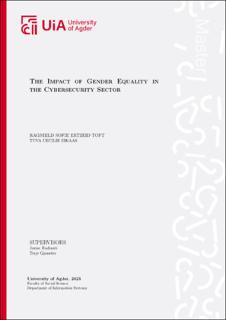| dc.description.abstract | Nowadays, there is a shortage of cybersecurity professionals in the sector and women are disproportionately underrepresented in the field. This exploratory study examines how organizations can retain and entice women in the cybersecurity industry, as well as how enhanced gender balance affects the work environment. Because the scope is limited, we will only look at gender equality between men and women, as well as apply the study in a Norwegian context. Furthermore, the study investigates why women are underrepresented in cybersecurity and identifies barriers preventing them from pursuing this career. The findings of our systematic literature review (SLR) identifies obstacles and already existing solutions for increasing the representation of female cybersecurity professionals. To gain a comprehensive understanding of respondents' experiences with gender equality and diversity in the industry, qualitative research using semi-structured interviews (SSI) was conducted. Our study contains fourteen respondents from organizations with cybersecurity from both private and public sectors, with varying positions. The primary metric that emerged from both the interviews and the literature was showing possibilities of cybersecurity and raising awareness of the subject. By analyzing our literature- and empirical findings we demonstrated that there is a correlation between the barriers preventing women from cybersecurity. According to our theory, stereotypes, disinformation, discrimination, lack of role models and lack of knowledge about the cybersecurity contributes to low self-efficacy, which causes low interest in the subject, which leads back to the first point. By understanding how this is connected, we were able to propose several recommendations to reduce the barriers and turn the vicious cycle into a virtuous one. Based on our results, we developed a list of recommendations for enticing and retaining more women in cybersecurity, which can be applied in both educational and organizational sector.
The study's primary purpose is to help advance gender equality in the cybersecurity industry by identifying the barriers that keep women out of the field and providing long-term solutions for enticing and retaining more women. The recommendations are applicable to organizations outside of the cybersecurity industry as well, and this research can thus be applied to a variety of male-dominated sectors. | |
